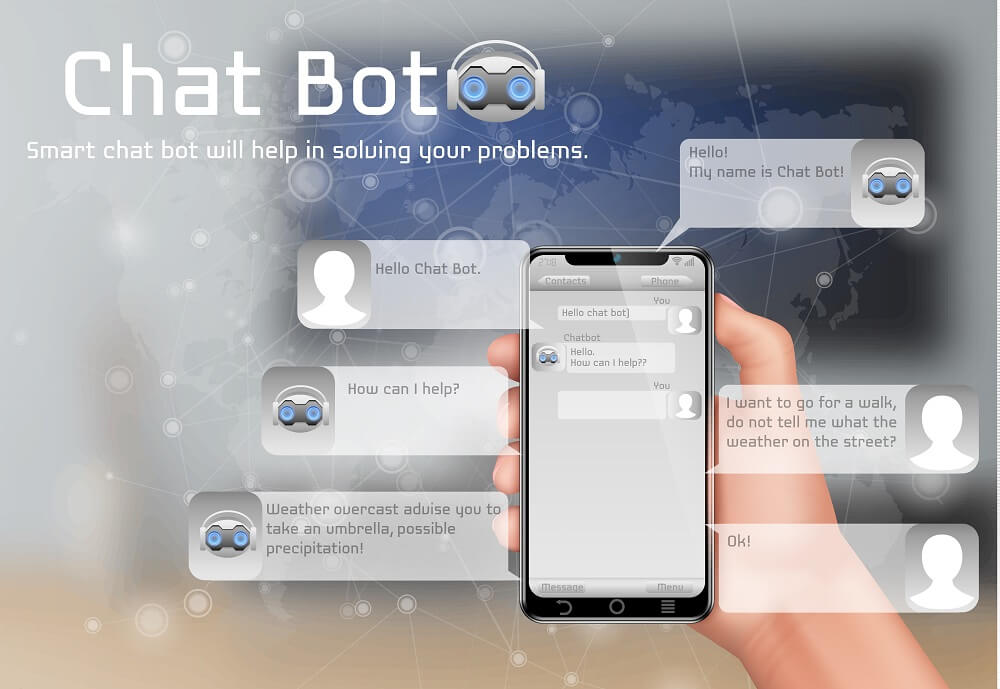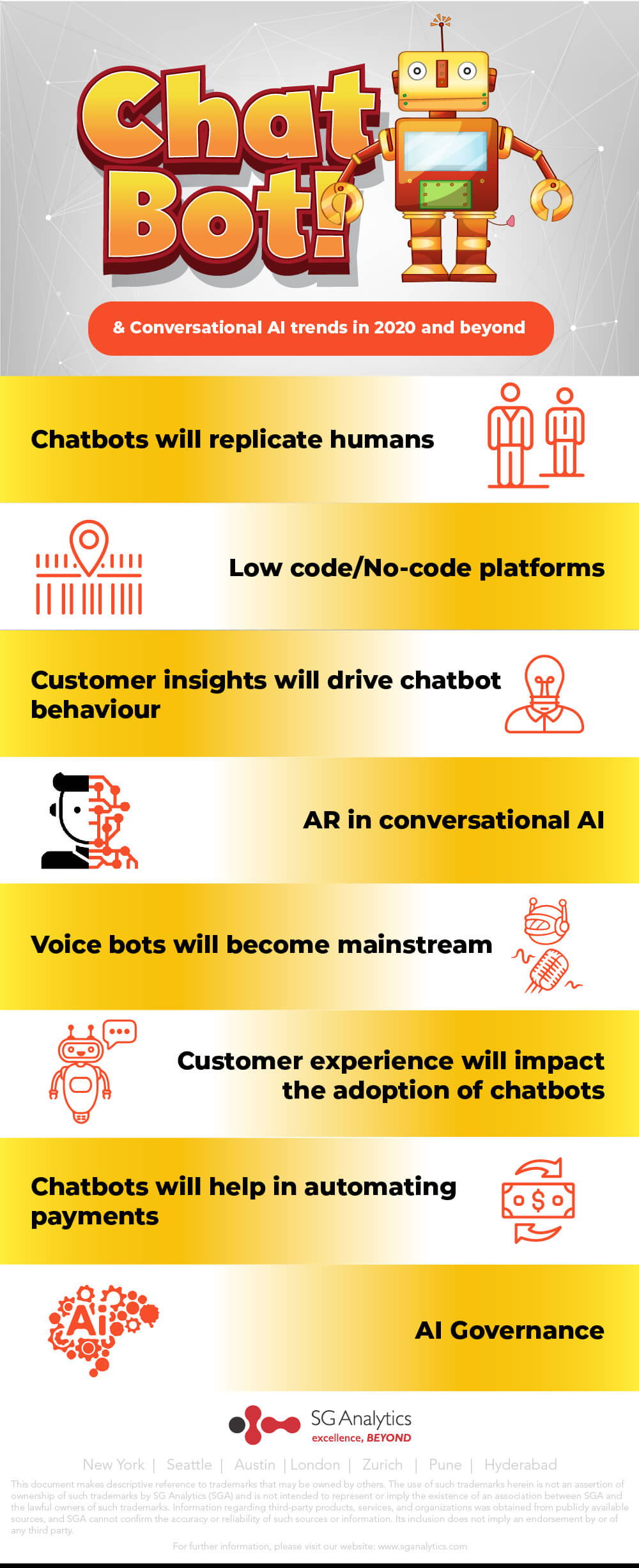Artificial Intelligence (AI) is disrupting almost every aspect of businesses in the present times. Chatbots, one of the key applications of AI, is greatly revolutionizing communication for businesses, both internally and with customers. This article discusses how chatbots and conversational AI will create a conversational disruption and enable businesses to gain efficiency and pace in today’s fast-changing digital world.
Chatbots – what are they capable of?
Powered by the rules of AI, chatbot technology is designed to converse or chat with users in natural language. In technical terms, chatbots are small programs that can automatically stimulate interactions with users/customers based on a set of predetermined rules, triggers, and events.
With AI becoming increasingly sophisticated, the role and value of chatbots are constantly increasing in modern times.

Conversational AI – a brief introduction
Conversational AI is a technology advancement that allows chatbots to interact with people just like a human would do. The prime goal of conversational AI is to narrow the gap between computer and human language and make communication easy and natural between the two.
With AI-powered chatbots becoming an integral part of households and businesses worldwide, chatbot development services and conversational AI is expected to become more agile and the market size is forecasted to reach a value of $ 15.7 bn by 2024.

Conversational AI and chatbots – understanding the difference?
While rules-based chatbots obey a predefined workflow, conversational AI empowers machines to understand, process, and respond to human language. With the advent of conversational AI, businesses can reduce customer frustration with primitive chatbot solutions and their limitations. In other words, using conversational AI, firms can go beyond just converting website content into simple chatbot responses.
Business applications of chatbots and conversational AI
Customer Service
Implementing chatbots along with other channels like social media, email, and live chat can help businesses in the following ways:
- Get prompt responses to queries
- Get more detailed answers to a query
- Find the optimal ways to interact with your business
- Get a befitting solution to a problem or complaint
Besides the above, AI-driven chatbots can help in predicting customer buying behaviours based on their purchase history.
Real-time Conversations
Today customers expect instantaneous responses/answers. Unless there is someone on the website prepared to quickly engage and respond to visitors, they will move ahead to connect with someone who will respond. According to estimates, there was a 50% increase in the number of responses when followed up in real-time (The Future of Commerce).
Lead Generation Automation
Chatbots can assist businesses in acquiring customers, even better than human agents. Since modern chatbots are NLP-driven, they can converse with customers just like a human. Also, automating the initial engagement with app users or site browsers without actual human agents, makes chatbots highly scalable and instrumental in identifying potential customers easily. Irrespective of the industry, businesses can use chatbots to their advantage and further establish cutting-edge competition in the target market.
Further, conversational AI helps in increasing the response rate. The chance of conversion is 5X more when the response to a prospect is within 5 minutes (The future of commerce). Firms that respond first have higher chances of closing a business deal and conversational AI can be of great assistance in this matter.
Customer onboarding and tutoring
Though businesses put in a lot of effort in curating attractive and informative content, most times customers don’t know where to find the information that intrigues them. Also, it is common these days, to remind customers about searched topics and other topics associated with it, once a conversation is started. Chatbots can be of great assistance in this scenario as they were specifically constructed to ask questions, gather answers, and automatically direct customers.
For instance:
- Hi! I’m Chris (Bot), How are things going? Let me know if I can be of any help
- May I know what kind of products you are looking for? We offer X, Y, Z
- Do you need any help with the ‘XYZ’ product? I have an article that can give you more details about the product. Would you like to try it?
- What is the preferred time you would like us to contact you?
And so on.

Chatbots also assist in nudging the customers along the conversion funnel. For example, chatbots can ask call-to-action questions like:
- Your account will expire soon. Can I walk you through the plans we offer?
- It seems like you have some issues with ‘ABC’. Would you like to discuss about this with our customer success manager?
- Looks like you haven’t added the logo yet. Would you like me to help you with it?
Chatbot and Conversational AI trends in 2020 and beyond
The chatbot ecosystem is expanding at an increased pace. According to estimates, there are currently more than 3,00,000 chatbots on Facebook (Venture beat). 50% of businesses plan to invest more in chatbots rather than mobile apps (smallbizgenius).
Chatbots will replicate humans
According to Global Market Insights, “the overall chatbot market size across the globe is likely to exceed $1.3 bn by 2024”. This clearly indicates that inevitably, the chatbot industry will be a driving force of business communications. The NLP-driven bots leverage predictive analytics and sentiment analysis to understand human conversations and the intent behind it.
Though there are some challenges in adopting AI technology and implementing chatbot best practices, businesses are still focusing on developing chatbots that can mirror human capabilities with the help of machine learning and natural language processing.

Chatbots driven by conversational AI can enable businesses to:
- Deliver tailored and personalized customer experience to build and strengthen customer relationships
- Boost customer loyalty while improving user experience with the brand
- Affect customer perception in a positive manner to build a positive and satisfied customer base
Low code/No-code platforms
Coding, particularly to meet requirement changes is a tedious task that results in increased time-to-market. While organizations are looking out for platform-based models to meet their emerging conversational AI needs, LowCode/NoCode platforms are the best solution to address the increased time-to-market issue. Also, these platforms are designed to increase the effectiveness and agility of firms and hence will continue to gain popularity in the upcoming years.
Customer insights will drive chatbot behaviour
As customers are becoming more human like in communication, the next step is to enhance the user experience. Sentiment analysis is essential to train the bot to replicate human capabilities, as it is not only about providing prompt responses but also about creating a delightful customer experience. Using sentiment analysis, chatbots can easily and effectively comprehend customers’ emotions behind their conversations and respond accordingly.
For instance, by applying sentiment analysis on the customer conversation recorded by chatbots, bots can identify whether a customer is happy or annoyed. This helps the bots to modify their responses according to the customer’s mood.
AR in conversational AI
Augmented Reality in chatbots is an exclusive technology that can improve usage and engagement level to a great extent. While AR is relatively a new technology for users as well as mobile/web apps, a chatbot within an app allows users to effectively use and experiment with the AR technology.
Based on the user’s behaviour and his/her position in the buying cycle, bots can prompt them using Augmented Reality. For example, customers can feel how a bean bag would look in their living room, how an apparel will look on them, etc, using AR technology. Leading enterprises like Amazon, IKEA, Zara, and Loreal, are currently testing the potential of the augmented reality technology.

Voice bots will become mainstream
“Ok Google, what’s my schedule today? – this has become a common phrase for most smart assistant or device users. As reported by Forbes, over 50% of searches will become voice-driven by 2020. Voice search mainly focuses on facilitating a seamless experience to users, thereby benefitting businesses indirectly.
According to a research conducted by Accenture, “Digital consumers choose mobile platforms with text-based and voice interfaces”. Below-mentioned are a couple of reasons why voice bots are gaining increased attention:
- While text can be monotonous, voice bots help in engaging with customers through automated intelligence-based communication
- Voice-enabled bots provide real-time as well as reliable customer insights
- Voice bots reduce issues related to customer needs and offer opportunities for personalization
Customer experience will impact the adoption of chatbots
In current times, when people are greatly influenced by social media, chatbots are gaining increased popularity among businesses. With the help of chatbots, businesses can automate various business functions and thereby improve customer experience. For instance, Chatbots are the best solution for those customers who expect an instant response (within 30 seconds).
Also, AI-driven bots are functional 24*7 and can be of significant assistance in handling information-based questions. Depending on the customer experience, firms can choose chatbots to interact with their customers.
Chatbots will help in automating payments
Chatbots are greatly revolutionizing the way businesses connect and interact with customers, run campaigns to generate leads, and automate payments. According to the stats published by Chatbots Magazine, 67% of US millennials have stated that they prefer purchasing products and services from brands that use a chatbot.

In the future, chatbots will enable businesses to automate payments and allow customers to pay directly through Facebook Messenger apps or live chat. Instant payment is one of the factors that can help businesses improve customer experience and satisfaction. For example, MasterCard has launched a chatbot specifically for customer payment.
AI Governance
AI governance is a legal framework constructed to ensure ML technologies are well studied and built with the prime goal of aiding enterprises to use AI systems effectively. The major objective of AI governance is to bridge the gap between accountability and ethics associated with technological advancements.
Wrapping Up
Chatbots are no longer a luxury, rather a necessity for businesses across industries to thrive in a customer-first and AI-driven world. Furthermore, automation will help businesses overcome the challenges in implementing chatbots. However, a deep and proper understanding of business requirements is essential to implement the appropriate chatbot strategy and kind of chatbot to improve customer journey and experience.









